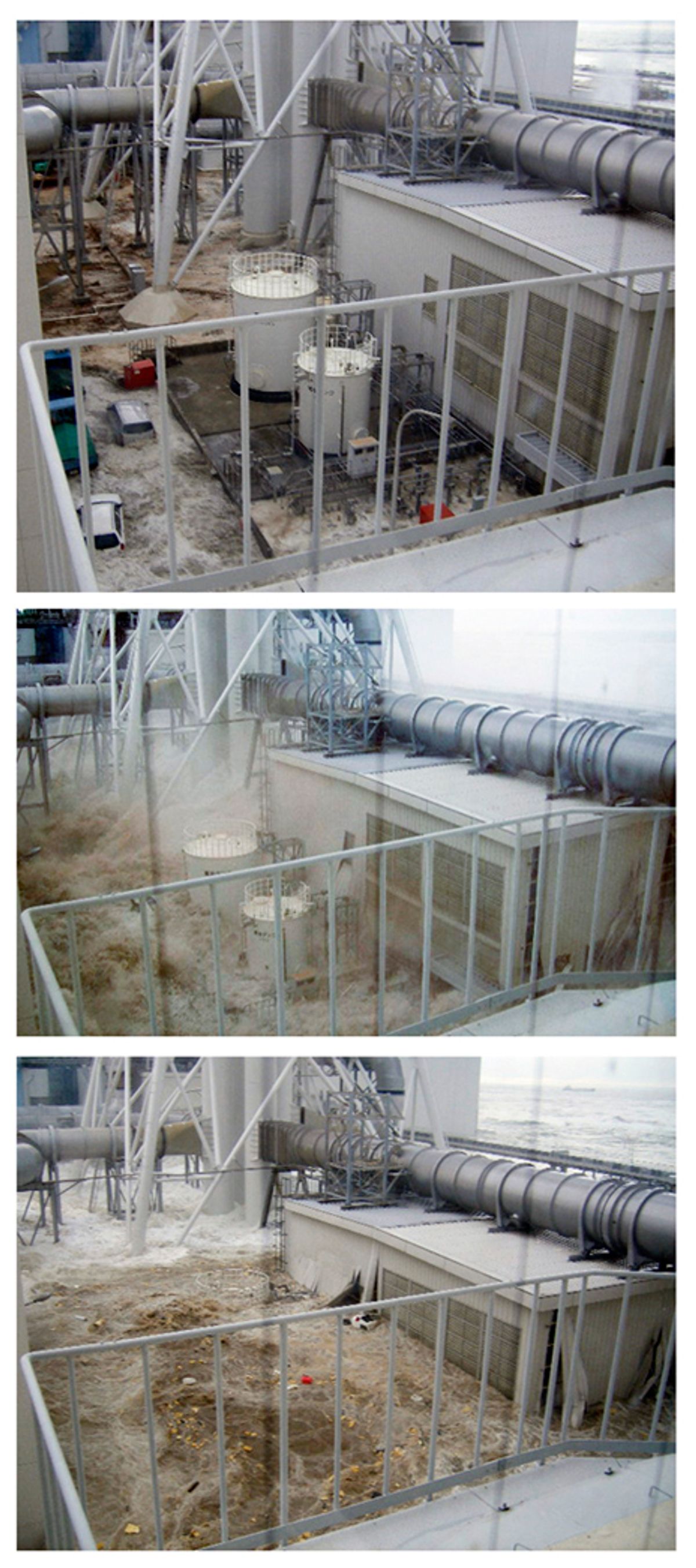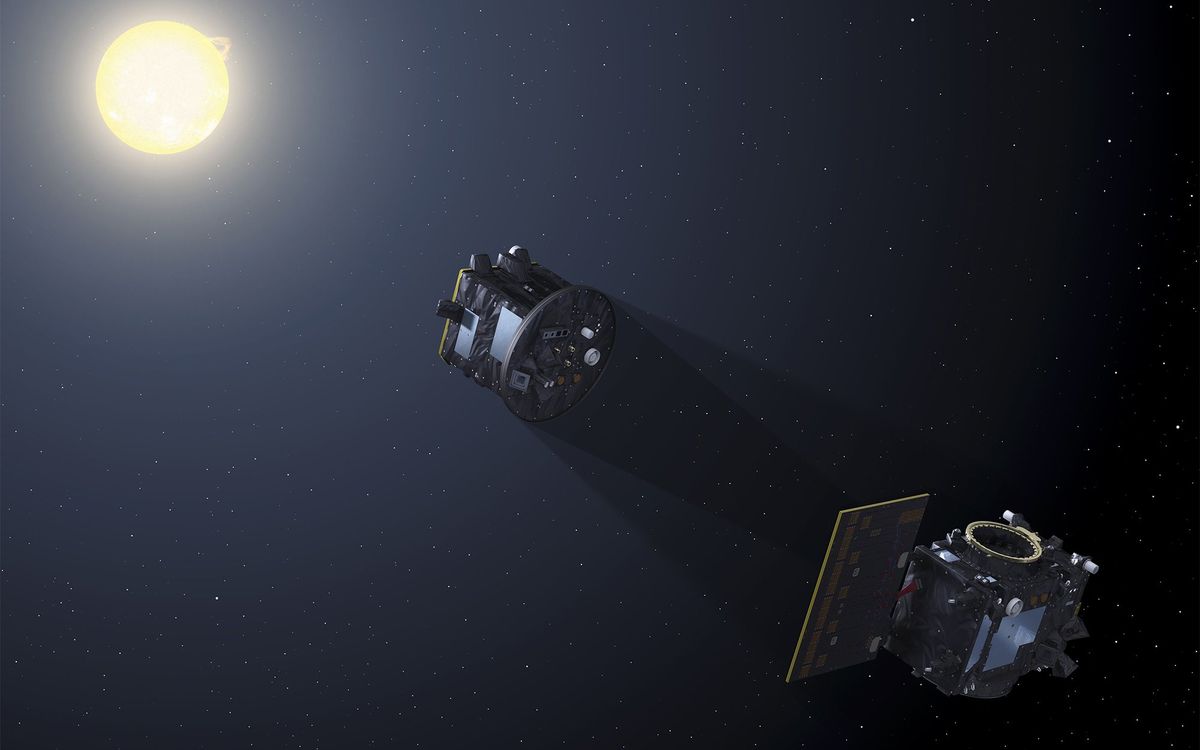Tsunami Effect: Water rushes into the Fukushima Dai-1 nuclear power plant after a tsunami. The photos were taken from the fourth floor of the of the radioactive waste disposal building on 11 March and release by TEPCO on 19 May.
Editor's Note: John Boyd is an IEEE Spectrum contributor reporting from Kawasaki, Japan.This is part of IEEE Spectrum's ongoing coverage of Japan's earthquake and nuclear emergency. For more details on how Fukushima Dai-1's nuclear reactors work and what has gone wrong so far, see our explainer.
Reactors numbers 2 and 3 of the Fukushima nuclear plant both suffered a partial meltdown within days of the March 11 earthquake. These are some the findings in a report produced by Tokyo Electric Power Co. (TEPCO) and delivered to a government safety agency today. The findings came after the company recently said a partial meltdown had occurred in the No. 1 reactor. The report only confirmed what many nuclear experts have been saying for some time, though TEPCO insists the melted fuel is being kept cool at the bottom of each pressure vessel. (TEPCO also suspects that the melted fuel in reactor No. 1 has damaged the bottom of the pressure vessel, allowing radioactive water—and possibly even some fuel—to leak down into the primary containment vessel.)
The TEPCO report is based on an analysis of the data recorded at the plant in the immediate aftermath of the earthquake and tsunami, as well as on interviews with plant operators present at the time, and was produced at the request of the Nuclear and Industrial Safety Agency (NISA).
Other details of the first hours following the accident have been made known. TEPCO said on Monday that after analyzing data up until the time of the tsunami it has concluded the earthquake caused no major damage to the reactors or piping. It wasn’t until the tsunami hit and all power sources and cooling systems were knocked out that abnormalities occurred.
Both TEPCO and the Japanese government have been taking lumps for their actions following the tsunami.
NHK, Japan’s national broadcaster, said it has obtained information that makes “it highly likely that TEPCO did not follow procedures to prevent a hydrogen explosion” in the No. 1 reactor building that occurred on 12 March, one day after the tsunami destroyed the reactor’s cooling system. A cooling system failure would cause the pressure in the reactor’s containment vessel to climb and raise the likelihood of a hydrogen explosion.
According to NHK, the TEPCO operating manual calls for venting the vessel when pressure is projected to rise to 853 kilopascals—twice the operating limit—in order to prevent damage to the vessel and the release of radioactive materials. According to the data NHK obtained, the pressure was close to the maximum figure 13 hours before the explosion happened at 3:36 p.m. on 12 March. Yet TEPCO did not start the venting procedure until six-and-a-half hours before the explosion. The slow start meant workers sent to do the venting were hampered by dangerously high levels of radiation. Apparently, the fuel rods had already begun melting by then and radiation was leaking from the reactor into the building.
This charge from NHK comes at a time when Prime Minister Naoto Kan is denying accusations that he instructed TEPCO to stop injecting seawater into the No. 1 reactor on 12 March, because of fears it would cause re-criticality—a dangerous situation that occurs when a nuclear system goes critical after measures have been taken to shut the system down. Sea water injection was an emergency procedure being carried out to cool the reactor after all the the plant’s own cooling systems had failed.
When TEPCO informed Kan on 12 March that it was running out of clean water and would change over to seawater, Kan discussed the changeover with advisors and was told the possibility of re-criticality “was not zero,” by Haruki Madarame, chairman of the Nuclear Safety Commission advising the prime minister. At 6 p.m. Kan ordered NISA to examine the possibility of re-criticality. Meantime, TEPCO began injecting seawater at 7:04, but soon stopped when it heard of Kan’s concerns. At 7:55 Kan ordered TEPCO to start the injection of seawater on the advice of his experts, and TEPCO resumed its injection at 8:20 p.m. Critics say the delay should have been prevented at all costs.
Even though much of the focus in the past week has been on what happened soon after the tsunami, the work on containing its effects continues. In an attempt to get more accurate readings of radiation emissions directly above the reactor buildings, TEPCO has begun using a pump vehicle with a dosimeter attached to a 15-meter-high pump arm. A TEPCO official said that until now it hasn’t been able to measure radiation “at the source. So we are going to take more detailed measurements to find out how much radioactive material is being dispersed into the environment.” The company took measurements above the No. 1 reactor building on Sunday and above the No. 4 reactor building on Monday. After analyzing the readings, TEPCO will decide whether to enclose the buildings with polyester sheets in a bid to prevent radioactive materials from escaping into the atmosphere.
After TEPCO reported a Y1.25 trillion ($15.4 billion) loss for fiscal 2010, company President Masataka Shimizu announced 20 May he was stepping down. Shimizu said he wanted to take responsibility for the disaster at the Fukushima nuclear plant and to give the company a symbolic new start. The accident “has undermined trust in nuclear safety and caused trouble for society,” Shimizu said at a press conference. Taking his place in June will be Toshio Nishizawa, currently the managing director. He will preside over a restructuring plan that includes the sale of assets and lay-offs to help deal with cost of the disaster.
Chinese Premier Wen Jiabao and South Korean President Lee Myung Bak joined Japan’s Prime Minister Kan on 21 May in touring the earthquake-ravished region in northeast Japan; they also visited Fukushima city, about 60 km from the crippled nuclear plant. In a joint declaration the following day, the three leaders said their countries would cooperate closely on disaster prevention and help ensure nuclear power safety through better and prompt information sharing. The leaders also vowed to improve communications between the pertinent bodies and said they'd consider conducting a joint rescue exercise.
[Updated on 26 May.]




